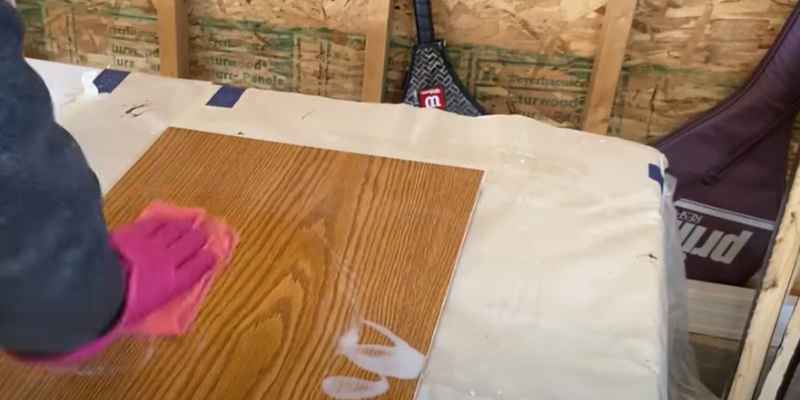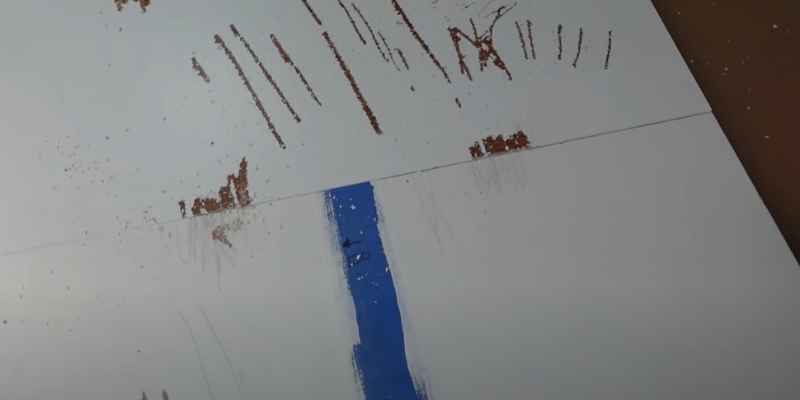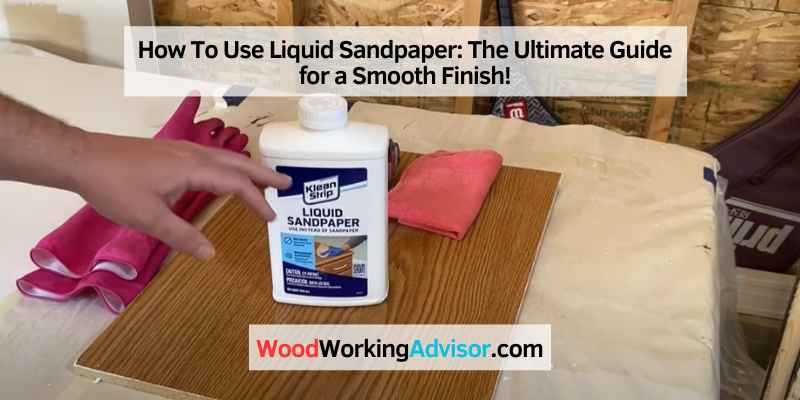To use liquid sandpaper, first, clean the surface you want to sand, then apply the liquid using a cloth or brush, let it sit for the recommended time, and wipe it off before painting or refinishing the surface. Liquid sandpaper is a convenient alternative to traditional sandpaper, helping to remove gloss, paint, and other finishes without the mess and effort of sanding by hand.
It is commonly used on wood, metal, and laminate surfaces, providing a smooth base for paint or stain. By following the proper usage instructions and safety precautions, you can achieve professional-looking results with liquid sandpaper.
What Is Liquid Sandpaper?
Liquid sandpaper is a handy tool that is commonly used in various home improvement projects and woodworking. It is a powerful solvent-based solution that serves as an alternative to traditional sandpaper. This product helps in preparing surfaces for painting, staining, or refinishing by eliminating the need for tedious and time-consuming sanding. With liquid sandpaper, you can achieve a smooth and clean surface without the hassle of dust and debris that often accompanies traditional sanding methods.
How Does It Work?
Unlike traditional sandpaper, liquid sandpaper works by dissolving the finish or varnish on a surface, rather than physically grinding it away. The main ingredient in liquid sandpaper is a powerful solvent that softens and loosens the existing finish or varnish, making it easier to remove. This solvent is typically a chemical compound, such as ethyl alcohol or acetone, which effectively breaks down the existing coat and eliminates the need for mechanical abrasion.
Using liquid sandpaper is simple. You just need to apply it to the surface with a cloth or sponge, making sure to cover the entire area evenly. Allow the solution to sit for the recommended time, which is usually indicated on the product label. During this time, the liquid sandpaper will work its magic by softening the finish, making it easier to remove.
Benefits Of Using Liquid Sandpaper
There are several benefits to using liquid sandpaper over traditional sandpaper. Here are some of the advantages:
- Time-saving: Liquid sandpaper eliminates the need for manual sanding, which can be a time-consuming task, especially when dealing with large surface areas or intricate designs.
- No dust or debris: One of the biggest hassles of traditional sanding is the mess it creates. Liquid sandpaper eliminates this issue, as it doesn’t produce any dust or debris.
- Improved efficiency: Liquid sandpaper is more efficient in removing stubborn finishes, as it can reach areas that may be difficult to access with sandpaper alone.
- Less physical exertion: Unlike sanding, which requires physical effort and can be tiring, using liquid sandpaper is a more effortless process. This makes it suitable for individuals with limited physical strength or mobility.
- Versatility: Liquid sandpaper is compatible with various materials, including wood, metal, and painted surfaces. It can be used on cabinets, furniture, trim, and other surfaces that require refinishing.

Preparing The Surface
To achieve a smooth and flawless finish when painting, it is essential to properly prepare the surface beforehand. This step not only ensures better adherence of paint but also helps to address any imperfections that may affect the final results. In this article, we will guide you through the process of preparing the surface using liquid sandpaper. Here are the three key steps to follow: cleaning the surface, repairing any imperfections, and applying the liquid sandpaper.
Cleaning The Surface
Before applying liquid sandpaper, it’s crucial to start with a clean surface. Dust, dirt, grease, and other debris can interfere with paint adhesion. Here’s how to effectively clean the surface:
- Wear protective gloves and eyewear to safeguard yourself.
- Remove any loose dirt or dust using a soft cloth or brush.
- If the surface is greasy, use a mild detergent diluted in water to clean it. Rinse with clean water after.
- For stubborn stains or marks, consider using a stronger cleaning solution specifically formulated for the surface material. Always follow the manufacturer’s instructions.
- Allow the surface to dry completely before moving on to the next step.
Repairing Any Imperfections
Next, it’s essential to address any imperfections on the surface to ensure a smooth and even finish. Here’s a step-by-step guide:
- Inspect the surface carefully for cracks, holes, or dents.
- If you spot any imperfections, use a putty knife to remove any loose debris or old paint around the damaged area.
- Apply a suitable filler, such as spackling compound or wood filler, to the imperfections.
- Smooth out the filler with the putty knife, ensuring it is level with the surrounding surface.
- Allow the filler to dry completely as per the manufacturer’s instructions.
- Once dry, use a fine-grit sandpaper to gently sand the filled areas until they are smooth and blend seamlessly with the rest of the surface.
- Remove any sanding dust with a clean, dry cloth.
By repairing any imperfections, you create a solid foundation for the paint to adhere to, ultimately delivering a professional-looking finish.
Applying The Liquid Sandpaper
Now that the surface is clean and flaws have been addressed, it’s time to apply the liquid sandpaper. This unique product replaces the traditional sanding process and prepares the surface for better paint adhesion. Follow these steps:
- Begin by shaking the liquid sandpaper bottle well to mix the contents.
- Pour a small amount of liquid sandpaper onto a clean cloth or sponge.
- Gently rub the liquid sandpaper onto the surface in a circular motion, ensuring complete coverage.
- Pay extra attention to areas that may have residue or stubborn stains.
- Allow the liquid sandpaper to sit on the surface for the recommended time specified on the product label.
- Finally, wipe off the liquid sandpaper residue using a clean cloth or sponge.
By following these steps to prepare the surface using liquid sandpaper, you can ensure optimal paint adherence and a professional-looking finish. With the surface clean, imperfections repaired, and liquid sandpaper applied, you are now ready to move forward with your painting project.
Applying Liquid Sandpaper
Applying liquid sandpaper is an important step in the refinishing process for furniture, cabinets, and other wooden surfaces. It allows you to smooth out the surface and remove any imperfections before painting or staining. In this section, we will discuss the key aspects of applying liquid sandpaper, including choosing the right product, safety precautions, and application techniques.
Choosing The Right Product
When selecting a liquid sandpaper product, consider the specific needs of your project. Some products are designed for heavy-duty applications, while others are more suitable for lighter surfaces. Look for a product that is compatible with the material you are working with, whether it is wood, metal, or other surfaces. Read the product label carefully to ensure it meets your requirements.
Safety Precautions
Before using liquid sandpaper, it is important to take proper safety precautions. Always wear protective goggles and gloves to prevent any contact with your eyes or skin. Work in a well-ventilated area or wear a mask to avoid inhaling any fumes. Keep the product away from open flames or sparks, as it may be flammable. Follow the manufacturer’s instructions on the product label for additional safety guidelines.
Application Techniques
To apply liquid sandpaper effectively, follow these simple steps:
- Start by preparing the surface you want to sand. Remove any hardware or accessories and clean the surface to remove dirt, grease, or other contaminants. This will ensure better adhesion of the liquid sandpaper.
- Shake the liquid sandpaper bottle well before use to ensure it is mixed thoroughly.
- Apply a generous amount of the liquid sandpaper onto a clean, lint-free cloth or sponge. Make sure to saturate it but not to the point where it drips excessively.
- Gently rub the surface in a circular or back-and-forth motion using the cloth or sponge. Apply even pressure to ensure consistent sanding.
- Allow the liquid sandpaper to sit on the surface for the recommended time, typically around 15-20 minutes or as indicated on the product label.
- After the recommended time, wipe off the excess liquid sandpaper using a clean cloth or sponge. Make sure to remove all residue to prevent any issues with paint or stain adhesion later on.
- Allow the surface to dry completely before moving on to the next step in your refinishing project, such as painting or staining.
By following these guidelines, you can ensure a smooth and even finish after using liquid sandpaper. Remember to always read and follow the instructions provided by the manufacturer to achieve the best results.
Sanding Technique
Learn how to effectively use liquid sandpaper as a sanding technique for your DIY projects. Discover step-by-step instructions and tips for achieving smooth and professional results without the need for traditional sandpaper.
Using Sandpaper Grits
One of the key aspects of using liquid sandpaper effectively is understanding the different sandpaper grits available. By selecting the appropriate grit, you can achieve the desired level of smoothness for your project.
Here are the common sandpaper grits, ranging from coarse to fine:
- Coarse grits (40-60): Ideal for removing old paint, varnish, or imperfections.
- Medium grits (80-120): Great for prepping surfaces before painting or staining.
- Fine grits (150-220): Perfect for feathering edges, sanding between coats, or creating a smooth finish.
- Extra fine grits (240+): Used for final sanding and achieving a polished result.
Determining which grit to use depends on the condition of the surface and the level of smoothness you desire. Starting with a coarser grit and gradually moving to finer grits can help you achieve excellent results.
Working With The Grain
When sanding with liquid sandpaper, it’s important to always work with the grain of the wood. This ensures a smooth, even finish and prevents damage to the surface.
Here’s how to work with the grain:
- Identify the direction of the wood grain by examining the texture and pattern of the surface.
- Hold the sandpaper firmly and sand in long, even strokes along the grain.
- Avoid applying excessive pressure, as it may result in uneven sanding or scratches.
- Continue sanding with the grain until you achieve the desired smoothness.
Remember, sanding against the grain can cause roughness, splintering, and damage to the wood surface. By working with the grain, you’ll achieve a professional-looking result.
Avoiding Over-sanding
Over-sanding can lead to undesirable outcomes, such as removing too much material or creating uneven surfaces. To avoid this, it’s essential to exercise caution and follow these guidelines:
- Start with a coarser grit and gradually progress to finer grits, as needed.
- Regularly inspect the surface to ensure you’re achieving the desired smoothness without excessive sanding.
- Avoid spending too much time sanding in a single spot, as it may result in uneven surfaces or dips.
- Use a sanding block or tool to distribute pressure evenly, preventing excessive material removal.
- Stop sanding once the desired level of smoothness is achieved.
By being mindful of these tips, you’ll be able to achieve optimal results with liquid sandpaper while avoiding the common pitfall of over-sanding.

Finishing The Surface
Liquid sandpaper is a highly effective solution for finishing surfaces. It simplifies the process by removing old paint and smoothing the surface, making it an essential tool for anyone looking to achieve a professional and sleek finish.
Removing Residue
Before you can begin the process of finishing the surface with liquid sandpaper, it is crucial to remove any residue or debris that may be present. Start by wiping down the surface with a clean cloth or sponge to get rid of any loose dirt or dust particles. You can also use a vacuum cleaner or a soft brush to ensure a thorough cleaning.
Next, use a mild detergent mixed with warm water to wash the surface, focusing on areas that may be sticky or greasy. Rinse off the detergent with clean water and pat the surface dry with a clean cloth. This step is essential to ensure the liquid sandpaper can properly bond with the surface and provide a smooth finish.
Applying Primer Or Paint
Once the surface is clean and free from any residue, you are ready to apply a primer or paint. The choice between a primer or paint depends on the desired result and the type of surface you are working with.
If you are using liquid sandpaper to prepare a surface for painting, it is recommended to apply a primer first. The primer will help the paint adhere better to the surface and provide a more durable finish. Make sure to choose a primer that is suitable for the type of surface and the intended paint.
To apply the primer, use a brush or a roller depending on the size of the surface. Start from one corner and work your way across, ensuring an even coat. Allow the primer to dry completely according to the manufacturer’s instructions before moving on to the next step.
If you prefer a more streamlined process, you can use liquid sandpaper that includes a built-in primer. This eliminates the need for a separate primer application and saves you time and effort. Simply follow the instructions on the product label to ensure proper application.
After the primer has dried, it is time to apply the paint. Again, choose a paint that is suitable for the surface and the desired finish. Using a brush or a roller, apply the paint evenly in smooth, overlapping strokes. Allow the paint to dry completely between coats, and apply multiple coats if necessary for the desired result.
Remember, proper surface preparation is key to achieving a professional-quality finish. By removing residue and applying a primer or paint correctly, you can ensure your project’s success and enjoy a smooth and long-lasting surface.
Conclusion
To sum up, liquid sandpaper is a versatile and efficient product for preparing surfaces before painting or refinishing. Its ability to remove stains, gloss, and roughen surfaces makes it an essential tool for DIY enthusiasts and professionals alike. With its ease of use and effective results, liquid sandpaper is a valuable addition to any toolkit.
So, next time you’re looking to revamp your furniture or give a new lease of life to your cabinets, give liquid sandpaper a try and enjoy the smooth and polished finish it provides. Happy sanding!


